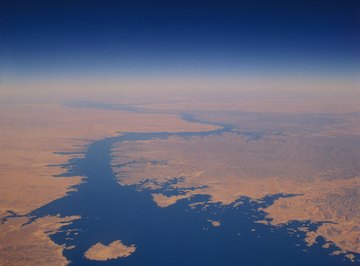
In Edgar Rice Burroughs’ fanciful novel “At the Earth’s Core” (1914), the adventurous young Englishman David Innes drills into Earth’s interior to find it hollow and habitable. In truth, he would have been crushed by pressure or burned alive by rising temperatures. That is because the Earth is differentiated into layers of varying density and temperatures, unlike the moon or a meteor, which are largely homologous, cold rocks.
Definition
The Earth’s differentiation describes its formation into layers, which include its iron-rich solid inner core, its molten outer core, its solid mantle and its crust on which we live.
Composition
The Earth’s core is its densest layer (about 7.87 gm/cm3), and is formed largely of iron-nickel alloys – heavy metals. Above it is the solid mantle consisting largely of peridotite (a rock, in turn, composed of the minerals olivine and pyroxene). The mantle accounts for about 80 percent of Earth’s volume. The mantle’s density is about half that of the core. Above that is the granite-rich crust, with a density of just 2.58 gm/cm3. Above the planet is the atmosphere, which was likely formed by release of gases from Earth’s molten interior. The early atmosphere was rich in carbon dioxide and sulfurous gases. Water may have been introduced by ice-carrying meteors that once rained upon the planet.
Formation
The young Earth, as a protoplanet, looked much like the Moon or an asteroid -- a cold rock, with the same composition on its surface as in its inner layers. Over time, three phenomena caused the Earth to heat up and become largely molten. The first was the radioactive decay of the elements uranium (U), thorium (Th) and potassium (K), all of which produced heat. Second was gravitational compression, or the planet “weighing in on itself,” in which gravitational potential energy was converted to heat during compaction. Denser materials, like the metal iron, migrated to the core while lighter materials such as silicates migrated outward to form the mantel and crust. Third were meteorites, which heated the Earth's surface via shock waves and impact. In time the temperature at the planet's interior rose to the iron (Fe) melting point (called the “iron event” by geologists).
Earth’s Future
We cannot assume that the process of differentiation is complete, although it remains stable, comparatively. It is possible that Earth’s internal heat will continue to drop to a point at which the planet is solid; at that point, Earth will be cold and dead like the Moon.
References
About the Author
Dan Antony began his career in the sciences (biotech and materials science) before moving on to business and technology, including a stint as the international marketing manager of an ERP provider. His writing experience includes books on project management, engineering and construction, and the "Internet of Things."
Photo Credits
Creatas Images/Creatas/Getty Images
